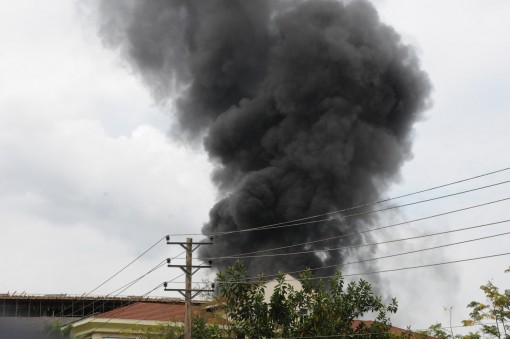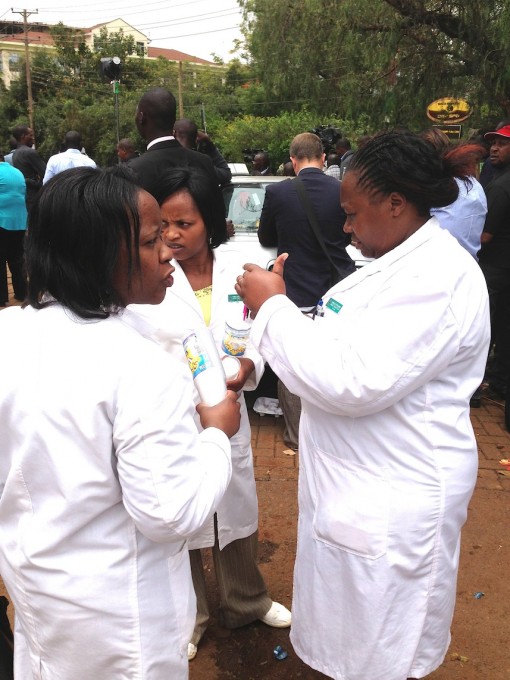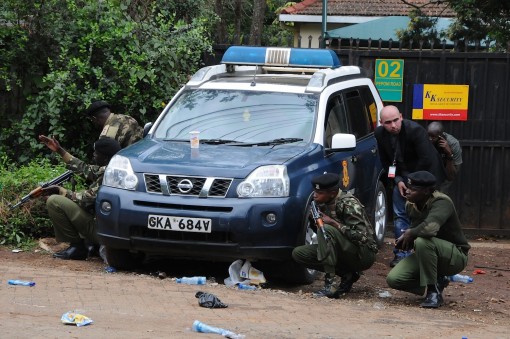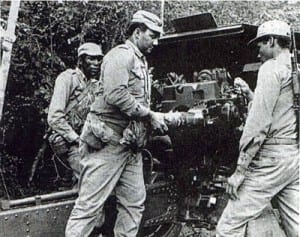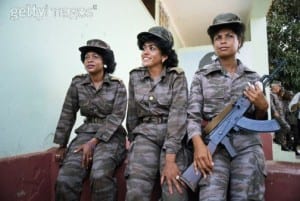What Really Happened at Westgate
Nairobi
Thick smoke hangs above the access road to The Westgate – the up-market shopping mall that serves mainly expats, UN staff and Kenyan elites.
Sporadic gunfire and explosions are clearly heard from the direction of the compound; overtaken on Saturday 21 September, by Somali fighters from the Muslim militant group Al-Shabaab.
Police forces and military duck for cover, and new troops are being bussed in order to take part in the operation.
Combat helicopters are circling around the site. Even higher than them, almost above the clouds, one can spot small airplanes. The sky is very busy. And it is overcast; the weather is gloomy and when the clouds are high up, aircraft are hardly visible.
Dozens of reporters, local and international, are shouting their dispatches into mobile phones. Some are Tweeting, or recording interviews with rescued hostages, nurses, and security officers.
Everything appears to be surprisingly well organized, including the supply of food, water and medicine. A Chinese clinic is offering help, as well as several voluntary organizations. People are donating blood. There are blankets and tents readily available.
But the gunfire keeps raging.
There are all sorts of speculations: the leader, the commander, is the ‘White Widow’, an English lady who was married to one of the Muslim attackers of the London Underground. Other ‘unconfirmed reports’ speaks about American jihadi fighters. And then, there is of course that semi-confirmed information about Israeli commandos, about US involvement and UK participation.
Who is inside that most luxurious shopping complex in East Africa? They say, there are no more than 10 attackers holed up inside, mainly Somalis, but there also others, some coming from outside the African continent. The rumors and official reports first speak about a few dozen hostages, then about 200. The number keeps swelling.
The armed forces and reporters are interacting.
“6 soldiers died”, one army officer whispers into my ear. “They do not admit it, but I know, I was just there”.
At one point I spot my Indian-Malaysian dentist, next to her son, also a dentist, who is said to have saved several people in the course of the first day. She is visibly shaken and her eyes are red, from lack of sleep, or maybe from tears.
It is all very emotional, very raw. Days and nights are blending together.
Al-Shabaab is Tweeting. It tells the world that the pain inflicted during those days is just a tiny fraction of what Kenya is inflicting on Somalia. Twitter is quickly shutting down all the sites of Al-Shabbab, but new sites are being instantly created.
***
Since 2011, Kenya has been occupying a substantial part of Somalia, and many analysts are questioning the legitimacy of this action. Oil rich southern Somalia is perhaps seen as the trophy by both Kenya, and the Western powers.
For years and decades now, the West has been destabilizing Somalia. Kenya and Ethiopia, two staunch allies of the West in the region, are playing a deadly game, incessantly. Thousands of civilians have already died.
Kenya is one of the closest allies of the West in Africa, with both US and UK military bases all over the nation, and with Israeli intelligence personnel on the Swahili coast and elsewhere.
That brutal invasion is not discussed, of course: in the Kenyan media and in the international press, the war and the attack on the shopping mall are carefully separated, disconnected.
And so is the brutality factor of the Kenyan troops in the territory of occupied Somalia: one can only judge from the stories told by refugees in Dadaab and other camps. The battleground is fully off-limits to foreign war correspondents – for our own protection, of course!
***
Efficiency appears to be only on the surface.
Dig deeper and chaotic pictures emerge.
Japanese acquaintances working for the UN, recalled how awfully unhelpful the local UN security system has been, since the attack:
“We were held in a bookshop, inside the Westgate. “ As the gunfight was raging all around, she and her little daughter were held for over two hours. She called the UN security. Their reply was chillingly laconic: ‘stay safe!’”
It took the Kenyan police 30 minutes to get to the scene. Their excuse was; they got stuck in a traffic jam!
A retired Peruvian UNICEF staff member was shot to death while inside a car, and his 13-year-old daughter was shot through her arm. She had to remain inside the car with her dead father for two hours, before being rescued.
It had been common knowledge among the expat community in Nairobi that the attack against the Westgate Mall was very likely to come. Al-Shabaab had been threatening almost ever since the Kenyan invasion of Somalia, that it was ready to blow up tall buildings in the capital. All local media carried these threats. Still, the security at all the shopping centers of Nairobi remained ridiculously lax.
And how is it possible that it took several days for the entire army and police to defeat a small band of insurgents, and even after that, only after foreign forces got involved?
***
By the latest count, around 130 people lost their lives, but the real number could still be much higher.
Rumors are there, still. Interpol issued arrest warrants and the hunt for the ‘White Widow’ is just beginning. And that despite the fact that one body, of a white woman, an insurgent, has already been found.
More bodies are being pulled from the rubble. Some people working inside the compound said that they could not exclude the possibility that several insurgents are still hiding in the rubble of the Mall.
But the most important question now is what will happen to war-torn Somalia. And what will happen to over two million Somalis (exact numbers are constantly being disputed) who are living in refugee camps like Dadaab, behind barbed wire, as well as in depressing neighborhoods around the Kenyan capital and other cities.
Westgate burning.
Westgate.
Soldiers before storming Westgate.
Nurses from Chinese Hospital.
Kenyan army and foreign element.
Jehova Witnesses taking advantage of chaos.
Helicopter near Westgate.
Battle scene.
Andre Vltchek is a novelist, filmmaker and investigative journalist. He covered wars and conflicts in dozens of countries. His discussion with Noam Chomsky On Western Terrorism is now going to print. His critically acclaimed political novel Point of No Return is now re-edited and available. Oceania is his book on Western imperialism in South Pacific. His provocative book about post-Suharto Indonesia and market-fundamentalist model is called “Indonesia – The Archipelago of Fear”. He just completed feature documentary “Rwanda Gambit” about Rwandan history and the plunder of DR Congo. After living for many years in Latin America and Oceania, Vltchek presently resides and works in East Asia and Africa. He can be reached through his website or his Twitter.
_______________________________
Nauseated by the
vile corporate media?
Had enough of their lies, escapism,
omissions and relentless manipulation?
Send a donation to
The Greanville Post–or
But be sure to support YOUR media.
If you don’t, who will?
